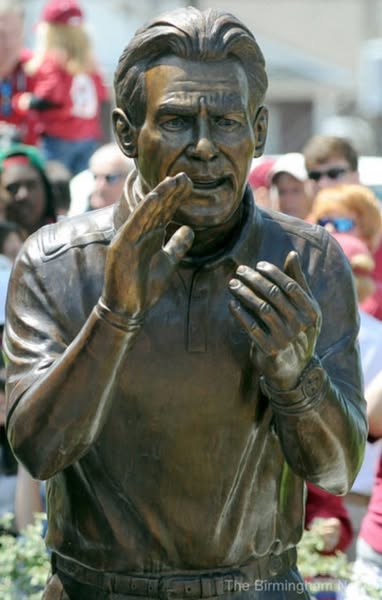Bear Bryant is considered by many to be one of the greatest college football coaches of all time, a legend whose name is etched permanently into the fabric of American sports history. Best known as the head coach of the University of Alabama football team, the Alabama Crimson Tide, from 1958 to 1982, Bryant’s career was a masterclass in leadership, discipline, and winning. Over the course of his 25-year tenure at Alabama, Bryant amassed an astonishing 232 wins, six national championships, and thirteen Southeastern Conference (SEC) titles. Yet his legacy goes far beyond the numbers; it is one built on a distinctive coaching style, a powerful presence on the sideline, and an unyielding commitment to excellence that transformed Alabama into a national powerhouse and set the standard for college football success.
Born Paul William Bryant on September 11, 1913, in Moro Bottom, Arkansas, he earned the nickname “Bear” after agreeing to wrestle a captive bear at a traveling carnival as a teenager. The name stuck and would come to symbolize the toughness and fearless nature he brought to the game. Bryant played college football at the University of Alabama from 1933 to 1935 under head coach Frank Thomas, contributing as an end on the Crimson Tide’s 1934 national championship team. His playing days were marked by toughness and grit, characteristics that would define his coaching style years later. After college, he began his coaching career as an assistant at Alabama before World War II interrupted his progression. He served in the U.S. Navy during the war, where he continued coaching at pre-flight schools and developed his leadership abilities in a military environment, something that deeply influenced his future coaching demeanor.
Bryant’s first head coaching job came in 1945 at the University of Maryland, but after just one season, he moved on to Kentucky, where he led the Wildcats to their first-ever SEC championship in 1950. Despite his success, tension with the administration and basketball’s dominance under Adolph Rupp led Bryant to leave Kentucky in 1954 for Texas A\&M. It was at Texas A\&M where one of the most legendary tales of Bryant’s coaching career unfolded. During his first training camp in Junction, Texas, he subjected his players to brutal conditions, pushing them to their physical and mental limits. Though criticized at the time, the “Junction Boys” experience became a defining moment that molded his future teams into warriors on the field.
In 1958, Bryant returned to his alma mater, the University of Alabama, to take over a struggling football program. What followed was one of the most remarkable coaching tenures in the history of college football. When Bryant took the helm, Alabama was coming off four consecutive losing seasons, a shocking fall from grace for a once-proud program. But it didn’t take long for him to turn things around. By his fourth season in 1961, Bryant had led Alabama to an undefeated season and a national championship. The Crimson Tide had officially returned to glory, and Bryant was the architect of their resurgence.
Over the next two decades, Bryant’s Alabama teams were the embodiment of dominance and consistency. His teams were tough, disciplined, and relentlessly prepared. Known for his signature houndstooth hat and no-nonsense demeanor, Bryant instilled a culture of accountability and unity. Players knew that playing for Coach Bryant meant giving your best on every play, in every practice, and in every moment. His practices were famously demanding, and his expectations were sky-high. But for those who embraced his system, the rewards were immense. Many of his former players speak about Bryant not only as a coach but as a father figure and mentor whose lessons carried far beyond the football field.
Bryant’s teams won national championships in 1961, 1964, 1965, 1973, 1978, and 1979. His 1970s squads, in particular, were a juggernaut, consistently ranked at the top of the polls and feared by opponents across the country. He coached two Heisman Trophy winners and dozens of All-Americans, and he helped send countless players to the NFL. But perhaps his most significant contribution to college football came in the form of progress and leadership during a time of racial segregation in the South. While the process of integration in college football was slow and complex, Bryant was instrumental in bringing African American players into the Alabama program, most notably with the signing of Wilbur Jackson in 1970. The arrival of Jackson and John Mitchell, the Tide’s first Black player to take the field, marked a turning point in both Alabama’s program and the South’s broader football landscape. Bryant’s leadership during this transition was quiet yet profound. He understood that to remain competitive, Alabama needed to reflect the nation’s changing culture, and he helped guide the program into a new, more inclusive era.
Throughout his tenure, Bryant was admired not just for his winning record but also for his adaptability. Unlike some coaches who were wedded to a single philosophy, Bryant adjusted his schemes to fit his personnel. In the early days, he relied on punishing defenses and methodical offenses. But when he saw the shift in college football during the 1970s, he installed the wishbone offense, a move that revitalized Alabama’s attack and led to some of his most dominant teams. His willingness to evolve kept Alabama competitive year after year, and his strategic brilliance allowed him to remain a step ahead of most rivals.
Bryant was more than a football coach. He was a symbol of Alabama pride, a larger-than-life figure who represented the toughness, resilience, and tradition of the South. On game days, he commanded respect and attention. Off the field, he was a quiet but impactful presence in the community. Despite his fame, Bryant remained grounded, never seeking personal glory. When asked about his accomplishments, he often redirected praise to his players and assistants. He believed deeply in teamwork, preparation, and humility—values that formed the cornerstone of his coaching philosophy.
By the time he retired after the 1982 season, Bryant held the record for most wins by a Division I coach with 323 victories. His final game was a win over Illinois in the Liberty Bowl, giving him one last moment of triumph. Just four weeks later, on January 26, 1983, Paul “Bear” Bryant passed away from a heart attack at the age of 69. His death shook the college football world and left a void that has never truly been filled. More than 300,000 people lined the streets of Tuscaloosa for his funeral procession, a powerful testament to his impact on the state of Alabama and the nation at large.
In the years since his death, Bryant’s legacy has only grown. He remains the gold standard by which all college football coaches are measured. Statues have been erected in his honor, documentaries have chronicled his life, and books continue to explore the nuances of his coaching genius. The Paul W. Bryant Museum on the Alabama campus is a living tribute to his achievements, drawing thousands of fans and visitors each year. Alabama’s football culture, still among the strongest in the country, traces its roots to the foundation that Bear Bryant built.
To this day, whenever college football greatness is discussed, Bear Bryant’s name invariably rises to the top. His ability to build winning teams year after year, to inspire loyalty and respect, and to leave a lasting impact on the game and his players sets him apart as more than just a coach. He was a leader of men, a pioneer in his sport, and a titan in American athletics. Bear Bryant didn’t just coach football—he defined it. His story is one of resilience, transformation, and unwavering excellence, and it will forever be etched in the annals of college football history.



